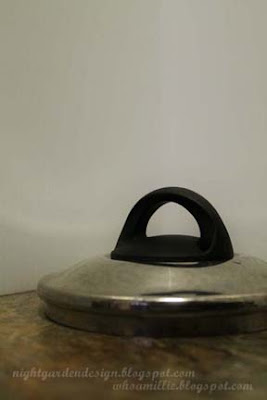On the other hand, I'm lucky enough to get to participate in the Young House Love/Bower Power Blog completely unauthorized Pinterest Challenge because of you, so maybe it's a draw?
Okay, fine. I love Pinterest. I've found it an endless source of inspiration and ideas. The only trouble I have is in distilling the content; I want to do everything. Like vertical gardening, for example. Wall pockets, hanging planters, cinder blocks, you name it, I want to make it.
original pin here
inspiration board dedicated to vertical and hanging planters and gardens here
Distill! Distill!
I took all those inspirational images and tutorials and made this: an upcycled wall planter homage to wall gardens. It wasn't exactly free, but it was pretty inexpensive, and mostly used materials (and plants) I already had on hand.
Materials:
Old iron planter basket (sans chains)
burlap coffee sack remnants
soil
pine shavings
hardware cloth or chicken wire remnant
awning remnant
hens & chicks
wire
thyme
heavy coat hook
Get an old iron planter basket (mine cost $2 at Bring). You'll need to acquire this first, as you'll use it to determine how large to cut your burlap and hardware cloth. You could also use an old bicycle wheel; one of the pins above makes a spinning planter with one. (Note: Bring marks prices with a paint pen; I've had good luck removing their prices with a Magic Eraser.)
After testing placement, replace your chintzy picture hanging hook with a nice, sturdy coat hook.
Sew a "pillow" from old coffee sack burlap, using twine pulled from the sack to sew it up. Turn it inside out and fill with a mixture of potting mix and pine shavings (to make it more lightweight).
Stitch the pillow closed and stuff it into your planter basket.
Cut some hardware cloth to the approximate size and shape of your container's back using tin snips. I had a large piece leftover from an old playhouse we tore down awhile back; chicken wire would work well, too. Cutting it down to an approximate size first makes it easier to work with when you're ready to do more exact cuts later.
Set aside your hardware cloth for the next step.
If you'll be hanging your vertical wall planter on a surface you want to protect marginally, you should add a waterproof layer so that the dirt and water don't soak through the burlap, causing stains and rot. You can use an old piece of tarp, or one of those poly pet food bags, or (like me) a piece of an awning destroyed in a windstorm. Cut it out and place it on top of your dirt pillow.
Trim down the hardware cloth to fit, then tuck it in place over the waterproof layer and use wire and some needle nose pliers to attach it to the basket.
Turn the pod over and lay it flat to begin filling in your plants.
I trimmed some of my hens & chicks plants down, and also added a divided thyme seedling and a whole lotta moss. (We'll see what survives!)
Poke or cut holes in the burlap and thread roots or runners into the holes.
Fill in around plants with moss.
I hung mine up right away for photos, but pretty much universally, it's agreed you should water it and leave it flat for a couple of weeks to allow the plants to take root. So after taking some pictures, I took the planter down again and laid it flat to do exactly that.
Patience is a virtue.
Thanks for reading, and thanks to Sherry and Katie for issuing the Pinterest Challenge! It's always good to have the chance to mark a project off my list . . . especially one that first caught my attention over a year ago.
Linking up to:



















































